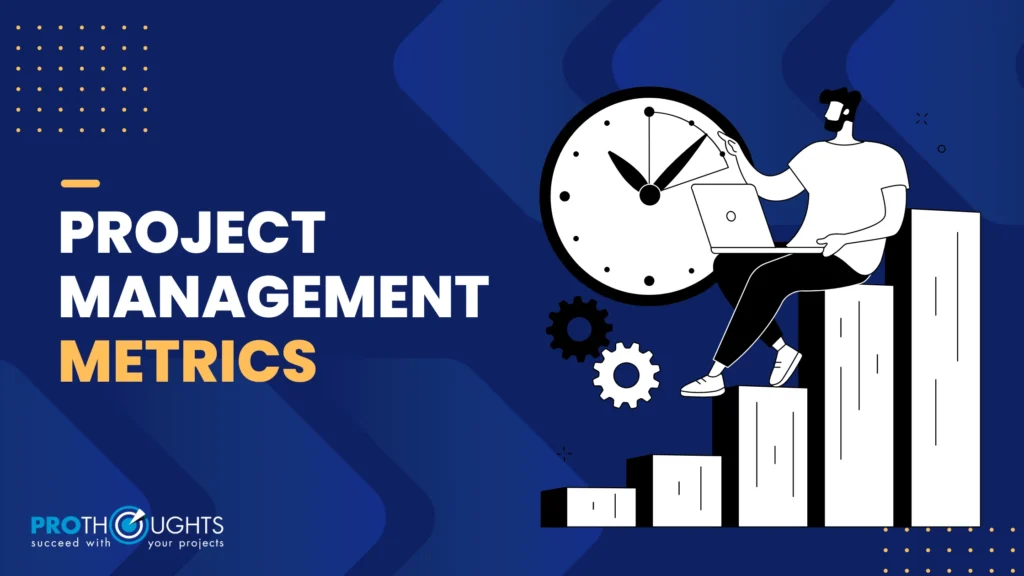Project managers must track their project’s process, evaluating aspects such as resource capability, completed versus unfinished work, and diversion from the planning and organizing. So, The following is where project management metrics come into play; they give managers useful data regarding the “health” of their projects.
What are these estimations, how are they assessed, and for what intention are they used? Let’s look into these issues.
What are Project Management Metrics?
The project management metrics are numeric to manifest different project performance measures such as extensiveness, progress, quality, and ability as it may be. As a result, project managers and stakeholders can determine whether the projects are progressing under their objectives, schedules, budgets, and quality standards by monitoring the provided metrics. Therefore, stakeholders can identify areas for improvement by analyzing project management metrics, make informed decisions using reliable information, and act backward when necessary to meet project goals.
Importance of Project Management Metrics
Project management metrics are incredibly important in many ways than you can imagine. They can help make the pmp process a lot easier. Moreover, they can help quantify a project’s performance and evaluate the effectiveness of a new campaign.
Measuring a project’s performance against certain pre-defined indicators helps reduce vagueness, brings clarity to the table, and paves the way for the success of the project. Everything is based on data and backed by proper facts and research. Businesses cannot afford to lose out on profits stemming from irrational and miscalculated decisions. Thus, with the correct metrics, it is now much easier to make well-informed choices on time to keep the organization moving in the right direction.
Furthermore, project management metrics not only help businesses stay on the right path but also prove beneficial in predicting calamities that may harm the organization in the foreseeable future. With the right change in tactics, businesses can then take action to avoid such disasters and stay with the competition.
What are the Examples of Project Management Metrics?
There are various types of project management metrics. It is not necessary to use all of them for every project. Quite the contrary. You just have to take the ones top suitable for the kind of project you are going to tackle. So, it is key to know the kinds of metrics there are to make the right choice. Hence, below are some examples of common project management metrics that businesses use:
1. Cost variance
Cost variance is an analytical estimate that balances the budget you have set for your project with the money spent. Here, you need to make sure that your cost variance remains positive. A positive cost variance indicates that your project is well within the budget. However, a negative cost variance shows that the costs exceed the budget set for the project. Cost variance helps manage the costs of your project and control the amount you are spending.
2. ROI
ROI is something you may have heard of before. It stands for return on investment. The formula below can be used to calculate it:
Formula – ROI= Net Return on Investment/Cost of Investment × 100%
It measures the return on investment of a particular project by comparing its value or benefits with its cost. Essentially, it measures the profitability of a project. An initiative’s benefits to the organization are determined by its ROI. When a project has a positive ROI, the work is profitable. On the contrary, a negative ROI shows that the project is not profitable because its overall expenses exceed its complete returns. Profitability and ROI are key aspects in considering the viability of any project.
3. Actual cost
Actual cost is one of the most simple but important project management metrics. It is the total cost of any project. To estimate the actual cost you just have to add up all of the expenses spent on the project. You can then balance this statistic with your complete gains to find out the total profit you have made across the lifespan of a project.
4. Productivity
The productivity of a project is a calculation of its efficiency. It can be conveyed by using an easy formula given below:
Productivity = Output / Input
It compares the total outputs with the total inputs of a project. In other words, it measures how much resources were spent on a project relative to the project’s gains. Ideally, you must target the highest level of efficiency possible. This means using the minimum money of intake to attain the highest money of results. It can give you a clear picture of how competently you are using your assets, making it a valuable metric to rate your project’s performance.
5. Budget
Anytime you begin any project you must have a financial plan in mind. This defines how much you are willing to spend on your project in monetary terms. It can be a rough estimate of the costs a business predicts it will incur for making the project a success. Additionally, the team tasked with implementing the project must ensure that the project stays within the budget. If the project goes over budget it is usually not a good sign. Also, It shows some miscalculations were made or the project was inadequately executed. A project going over budget may also be due to improper planning.
Collecting and Analyzing Project Management Metrics
1. Identification of Relevant Metrics
The process starts by listing what metrics are the most significant to the project’s goals, stakeholders, and key performance indicators. Measuring these metrics may show timeliness, cost, good quality of project management methodologies, and the level of satisfaction.
2. Data Collection and Documentation
However, it is critical to begin with relevant metrics, for the data collection method and source are established then. This might appear through such sources as project management software, team reports stakeholder feedback, and others that are considered important. Also, it is a critical thing to store the data systematically to make sure that the data is not distorted and that it has the same values at all times.
3. Regular Monitoring and Tracking
Project metrics are monitored and tracked through every step of its project life cycle This is concerning gathering data at specific time frames put forward, be weekly or monthly, to understand how things are faring. Additionally, frequent tracking allows this process to spot the ups and downs, as well as the derailment from desired goals and objectives.
4. Analysis and Interpretation
The analyzed data are used to draw out meaningful industry insights and investment opportunities. In this process, the comparison of what was achieved against the intended objectives, detection of deviation causes’ identifications, and assessing the effects on the project’s goals are carried out. Moreover, the information obtained allows project managers to discover both what is already done, or else, on the contrary, it underlines what can be improved.
5. Identification of Key Trends and Patterns
Using analysis as a primary tool, the most vital tendencies and patterns in a project’s performance are recognized. Those trends could be either a reliability gauge or the basis for future work. For example, the long-term trend of the unfulfilled budget may be due to inappropriate resource allocation, while the recurring declining stakeholder satisfaction scores might be rooted in poor communication practices.
6. Decision-making and Action Planning
Taking into consideration project management metrics, and identifying influencing factors, proper decisions can be made to solve problems and harness strengths. Impact plans are outlined to effect the remedies, the caution measures, and the enrichment for the project efficiency. Also, it might be the case of adjusting the budget, worsening the project schedule, or enhancing the project operations.
7. Continuous Improvement
Gathering and analyzing project management metrics get better and better when they do iterative and ongoing processes. Given ongoing review, interpretation, and communication no element of the project goes finalized without being reviewed and revisited if needed. The previous projects’ experiences and Pinpointing the finest project success practices are a part of the Project.
Conclusion
Project management metrics are extremely important for the success of any project. They help track the performance of every initiative and ensure your team is on the correct path for the success of the business. However, without using any metrics for project management it can be increasingly difficult to predict if the project is doing well or not.
So remember to have pre-decided project management metrics set in stone right at the beginning of your next software development project. They will help you massively stay up to date with the latest trends, analytics, numbers, and figures so you can make tweaks accordingly and make your project all the more profitable.


